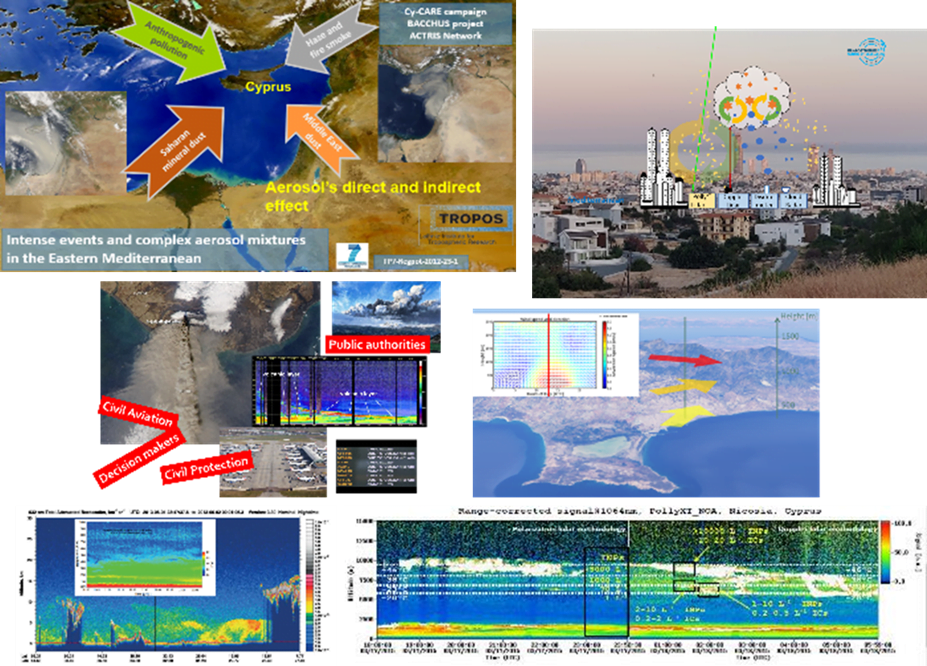Atmosphere
At the beginning of the EXCELSIOR project, the Atmosphere cluster of the ERATOSTHENES Centre of Excellence (ERATOSTHENES CoE) focused on the establishment of the Ground-based Atmospheric Remote Sensing Station (GBS). The main focus was given to the installation of new instruments, the integration of the new research infrastructure of the GBS into Cyprus Atmospheric Remote Sensing Observatory (CARO), and their operation in Limassol.
CARO is a National Facility (NF) for remote sensing of aerosol and clouds and is planned to become an ACTRIS National Research Infrastructure facility for Cyprus consisting of the aerosol remote sensing (ARS) observational platform and the cloud remote sensing (CRS) observational platform. The ARS platform runs a sun photometer of the AERONET network and a multiwavelength Raman lidar part of the PollyNET network. The CUT-TEPAK station is an in-kind contribution of the Cyprus University of Technology (CUT), and the PollyXT-CYP lidar is an in-kind contribution of TROPOS, both to ERATOSTHENES CoE for the EXCELSIOR project. In terms of becoming a national facility (NF) of the European Research Infrastructure ACTRIS, CARO is expected to be fully functional and ready for labelling in the summer of 2024. The ARS observational platform is already ready for this effort. Delays are related to the delayed delivery and installation of the 35-GHz cloud radar of the Cloud Remote Sensing (CRS) observational platform. It is expected to operate the finalised CRS sub-unit at Limassol in April 2024.
In brief, the sector of Atmosphere activities and research topics are the following:
- Air Quality and Air pollution monitoring
- Aerosol-Clouds-Precipitation Interaction
- Atmospheric Dynamics and Wind
- Monitoring of Extreme Atmospheric Events
- Dust storms and Dust intrusion
- Climate change monitoring
- Atmospheric model Validation & Assimilation
- CAL/VAL Activities for Satellite Mission
- Planning ACTRIS National Facilities
- Aerosol and Cloud Remote Sensing Observational Platforms
Cyprus provides a strong environment for demonstrating and further development of climate observation technology in a key region of climate change. This unique position is expected to attract international companies and leading researchers. Air quality monitoring and forecasting will be improved for the whole population of the Eastern Mediterranean, Middle East and North Africa (EMMENA) region.
As a result of the capacity building of the CARO team received by TROPOS, our EXCELSIOR advanced partner, related to the installation, maintenance, and full operation of the aerosol component of the GBS, the CARO team of the ERATOSTHENES CoE participated in a pilot campaign for NRT (near real-time) lidar observation provision for assimilation into forecast models provided by CAMS. The PollyXT-CYP system participated in the first pilot campaign coordinated by ACTRIS, with the contribution of TROPOS which provided the tools and the expertise in the provision of NRT data. This activity is estimated to restart in September 2023 and to continue and enhance the activities and developments achieved during the previous CAMS21b contract.
A major step towards recognition of the value of the infrastructure build in Limassol is represented by a submission of a cal/val project for the future mission EarthCARE that will be launched by ESA/JAXA in 2024. This proposal will make use of both aerosol and cloud profiling remote sensing instruments of CARO, and will address, together with the Energy sector of Eratosthenes CoE, all three remote-sensing components (lidar, cloud radar, radiation) of the EarthCARE satellite. In this proposal, also the USRL team of CARE-C/CyI is involved.
Following the installation, operation and trainings of the available instruments, the next step is the capacity building activities for the data transfer scripts, the processing chains, the installation of software analyses and the archiving protocols. Progress in capacity-building strongly depends on the availability of servers, both for the operation of the GBS, as we as a central server of ERATOSTHENES CoE. Currently, the PollyNET processing chain is running at TROPOS servers and all the available data of the GBS (PollyXT and DWL) are stored at the TROPOS servers. Once the server infrastructure for the GBS is hosted at the ERATOSTHENES CoE, the capacity-building activities will start and the PollyNET processing chain will be installed on the ERATOSTHENES CoE server.

